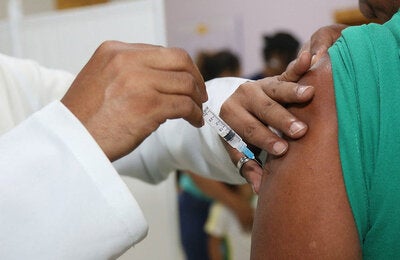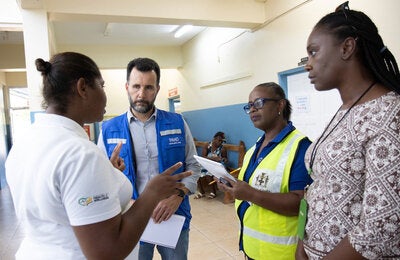
Combatting “toxic masculinity” is likely to reduce various forms of violence, STIs, unwanted pregnancies, absent fatherhood, and lack of shared unpaid caring responsibilities.
Washington, DC, January 30, 2019 (PAHO)- Men’s health as an issue warranting specific attention has begun to attract more notice as growing evidence emerges of differential epidemiological trends between men and women, particularly with respect to men’s premature mortality from noncommunicable diseases (NCDs) and morbidity linked to poor health-seeking behaviors, mental health and violence, including homicide and injuries. In almost every country of the world, men are more likely than women to die before age 70 (2–4), and data from the World Health Organization (WHO) suggest that approximately 52% of all NCD deaths worldwide occurred among men. Across the life course, mortality is higher in men than in women, and overall life expectancy for men is universally shorter. Compared with women, men have a mortality rate 4 times greater due to external causes and a 7 times greater risk of dying from homicide. The probability of men dying from cardiac ischemic diseases is 75% higher compared with women. Furthermore, 36% of deaths in men are preventable, compared with 19% in women.
"Compared with women, men have a mortality rate 4 times greater due to external causes and a 7 times greater risk of dying from homicide".

Dr. Carissa F. Etienne, PAHO/WHO Director
Unhealthy diet and lifestyles, tobacco use, and harmful use of alcohol are well known to be the major risk factors for NCDs, and underutilization of primary health care services by men has been identified as a problem in many countries around the world. The reasons why these risk factors disproportionately affect men are often related to the ways in which society educates us to understand our identities and roles as men and women – whether in relation to family responsibilities, working life, leisure time activities, or the need to access health services. In other words, men’s risk-taking behaviors and their underutilization of health services are strongly linked to gender differences and predominant norms of masculinity – what it means to be a “man.”
Across the life course, the way men learn to think about and project an image of themselves is often an inextricable part of the explanations of men’s premature death due to stress and unhealthy behaviors such as reckless driving, alcohol consumption, and drug abuse as well as risky sexual behaviors, high-risk sports and leisure activities. These gender norms vary according to social and cultural contexts but are often consistent across countries in terms of health behaviors. Socioeconomic inequities also play a role in determining how these norms affect health, as beliefs and expectations about men’s behavior – for example, that men should be the sole provider of family income – can become risk factors when exacerbated by lack of economic opportunities and social marginalization, thereby contributing to men’s poor health behaviors and high rates of morbidity from preventable diseases, particularly suicide.
To date, little systematic research has examined the relationship between masculinity and men’s health. While some studies have focused on the hazardous influences of male behavior, many of these have been criticized for seeming to assume that women and men have innate psychological traits and needs governing their behavior. Gender analyses of health have examined the ways in which social constructions of gender identity affect health. However, such studies have tended to focus on the negative effects of gender inequalities and “toxic masculinities” on women and their health and the need to empower women in order to guarantee their right to health. Much less attention has been paid to the relationship between the gendered nature of men’s identities and aspects of men’s ill health.
More gender-sensitive health research and practice, along with integrated approaches, are urgently needed to better understand the relationship between masculinities and different aspects of men’s health. This improved knowledge base could help health policy makers and practitioners to address some of the health-related beliefs and behaviors and work with men to improve their health to accelerate progress toward universal health. Promoting a more diverse understanding of what it is to be a man and addressing how these beliefs influence health can also address the often negative relationship between masculinity and other structural drivers of health – such as ethnicity, sexual orientation, age, income, etc. Such efforts clearly have benefits for men’s health and well-being but also contribute to gender equality and women’s empowerment, as combatting “toxic masculinities” is likely to reduce various forms of violence, STIs, unwanted pregnancies, absent fatherhood, and lack of shared unpaid caring responsibilities.
In these and other ways, increased attention to the issue of masculinities and men’s health could potentially contribute to a number of Sustainable Development Goals, including those related to NCDs, gender inequality, and reducing inequalities in physical and mental health and well-being. For the Pan American Health Organization, addressing masculinity and men’ s health is a priority to advance universal health and the gender equality agenda. We at PAHO are convinced that efforts to improve public health must include attention to both men’s and women’s health, reducing gender inequality, and improving well-being across the life course.
* By Carissa F. Etienne, Director, Pan American Health Organization (PAHO).
** This editorial was first published in December 2018 in the Pan American Journal of Public Health’s Special Issue on men’s health.
*** Also see the Special Issue on Women’s health.



